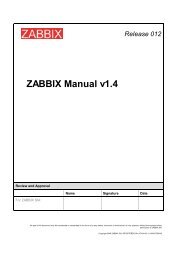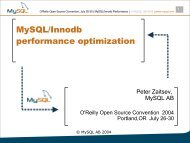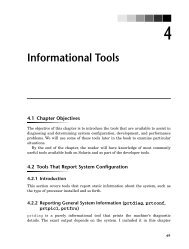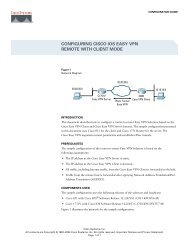OpenVPN Access Server System Administrator Guide
OpenVPN Access Server System Administrator Guide
OpenVPN Access Server System Administrator Guide
You also want an ePaper? Increase the reach of your titles
YUMPU automatically turns print PDFs into web optimized ePapers that Google loves.
The Hostname or IP Address is the name or IP address that VPN Clients will use to access the<br />
VPN <strong>Server</strong>. Thus, it must be a public IP address or Fully-Qualified Domain Name (FQDN). It is<br />
strongly recommended that a FQDN be used for this setting.<br />
The Protocol specifies whether TCP or UDP is used for VPN client-to-server communication. In<br />
general, Multi-Daemon mode is preferred as this gives you the option to use https:// without the<br />
specification of the port when accessing the Admin or Connect Client as well as the use of UDP<br />
when connecting to the VPN. By default, when multi-daemon mode is enabled, the client will first<br />
try to connect via UDP and if it is unable to connect via UDP it will attempt to connect via TCP.<br />
The reason UDP is first tried is because you can run into TCP meltdown when accessing certain<br />
TCP traffic over the VPN tunnel.<br />
Multi-Daemon Mode: On the <strong>Server</strong> Network Settings page, you will see a new protocol option<br />
"Both" along with TCP and UDP. When "Both" is checked, multi-daemon mode is enabled. In<br />
this mode, you will see some new fields appear on the <strong>Server</strong> Network Settings page that allow you<br />
to define the TCP and UDP ports, and how many daemons to run concurrently for each. In<br />
addition, when "Both" is checked, the Connect Client will return <strong>OpenVPN</strong> client configurations<br />
that will adaptively try UDP first, then fail over to TCP if no response is received within 4 seconds.<br />
The connectivity test has also been extended to handle multi-daemon mode -- both TCP and UDP<br />
ports will be tested for connectivity when multi-daemon mode is enabled.<br />
Service Forwarding is selectable when the VPN <strong>Server</strong> Protocol is chosen to be TCP. The Admin<br />
Web UI and/or the Client Web <strong>Server</strong> can be made available through the VPN <strong>Server</strong>. Of course,<br />
<strong>OpenVPN</strong> <strong>Access</strong> <strong>Server</strong> <strong>System</strong> <strong>Administrator</strong> <strong>Guide</strong><br />
22
















